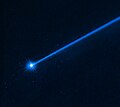File:Hubble sees boulders escaping from asteroid Dimorphos (heic2307a).jpg
Page contents not supported in other languages.
Tools
Actions
General
In other projects
Appearance

Size of this preview: 674 × 599 pixels. Other resolutions: 270 × 240 pixels | 540 × 480 pixels | 864 × 768 pixels | 1,152 × 1,024 pixels | 1,505 × 1,338 pixels.
Original file (1,505 × 1,338 pixels, file size: 522 KB, MIME type: image/jpeg)
| This is a file from the Wikimedia Commons. Information from its description page there is shown below. Commons is a freely licensed media file repository. You can help. |
Summary
| DescriptionHubble sees boulders escaping from asteroid Dimorphos (heic2307a).jpg |
English: This NASA/ESA Hubble Space Telescope image of the asteroid Dimorphos was taken on 19 December 2022, nearly four months after the asteroid was impacted by NASA’s DART (Double Asteroid Redirection Test) mission. Hubble’s sensitivity reveals a few dozen boulders knocked off the asteroid by the force of the collision. These are among the faintest objects Hubble has ever photographed inside the Solar System. The ejected boulders range in size from 1 metre to 6.7 metres across, based on Hubble photometry. They are drifting away from the asteroid at around a kilometre per hour. The discovery yields invaluable insights into the behaviour of a small asteroid when it is hit by a projectile for the purpose of altering its trajectory.[Image Description: The bright white object at lower left is the asteroid Dimorphos. It has a blue dust tail extending diagonally to the upper right. A cluster of blue dots surrounds the asteroid. These are boulders that were knocked off the asteroid when, on 26 September 2022, NASA deliberately slammed the half-tonne DART impactor spacecraft into the asteroid as a test of what it would take to deflect some future asteroid from hitting Earth. Hubble photographed the slow-moving boulders in December 2022.] |
| Date | 20 July 2023 (upload date) |
| Source | Hubble sees boulders escaping from asteroid Dimorphos |
| Author | NASA, ESA, D. Jewitt (UCLA) |
| Other versions |
|
Licensing
| ESA/Hubble images, videos and web texts are released by the ESA under the Creative Commons Attribution 4.0 International license and may on a non-exclusive basis be reproduced without fee provided they are clearly and visibly credited. Detailed conditions are below; see the ESA copyright statement for full information. For images created by NASA or on the hubblesite.org website, or for ESA/Hubble images on the esahubble.org site before 2009, use the {{PD-Hubble}} tag.
Conditions:
Notes:
|
This file is licensed under the Creative Commons Attribution 4.0 International license.
Attribution: ESA/Hubble
- You are free:
- to share – to copy, distribute and transmit the work
- to remix – to adapt the work
- Under the following conditions:
- attribution – You must give appropriate credit, provide a link to the license, and indicate if changes were made. You may do so in any reasonable manner, but not in any way that suggests the licensor endorses you or your use.
Captions
This NASA/ESA Hubble Space Telescope image of the asteroid Dimorphos was taken on 19 December 2022, nearly four months after the asteroid was impacted by NASA’s DART (Double Asteroid Redirection Test) mission.
Items portrayed in this file
depicts
image/jpeg
1,338 pixel
1,505 pixel
534,475 byte
2c6df9e0f2014ca75be69c167397efe10acb6c11
20 July 2023
3oa07vw42yglymf21gmbyqz0h4ai1kd3zp5s8f26nqhnulah64
File history
Click on a date/time to view the file as it appeared at that time.
| Date/Time | Thumbnail | Dimensions | User | Comment | |
|---|---|---|---|---|---|
| current | 09:00, 21 July 2023 |  | 1,505 × 1,338 (522 KB) | OptimusPrimeBot | #Spacemedia - Upload of https://cdn.spacetelescope.org/archives/images/large/heic2307a.jpg via Commons:Spacemedia |
File usage
The following page uses this file:
Global file usage
The following other wikis use this file:
- Usage on de.wikipedia.org
- Usage on ro.wikipedia.org
Metadata
This file contains additional information, probably added from the digital camera or scanner used to create or digitize it.
If the file has been modified from its original state, some details may not fully reflect the modified file.
| Author | Space Telescope Science Institute Office of Public Outreach |
|---|---|
| Copyright holder |
|
| Source | ESA/Hubble |
| Credit/Provider | NASA, ESA, D. Jewitt (UCLA) |
| Image title |
|
| Short title |
|
| Usage terms |
|
| Date and time of data generation | 16:00, 20 July 2023 |
| JPEG file comment | This Hubble Space Telescope image of the asteroid Dimorphos was taken on December 19, 2022, nearly four months after the asteroid was impacted by NASA’s DART mission (Double Asteroid Redirection Test). Hubble’s sensitivity reveals a few dozen boulders knocked off the asteroid by the force of the collision. These are among the faintest objects Hubble has ever photographed inside the solar system. The free-flung boulders range in size from three feet to 22 feet across, based on Hubble photometry. They are drifting away from the asteroid at a little more than a half-mile per hour. The discovery yields invaluable insights into the behavior of a small asteroid when it is hit by a projectile for the purpose of altering its trajectory. |
| Software used | Adobe Photoshop 24.4 (Macintosh) |
| File change date and time | 12:49, 11 July 2023 |
| Date and time of digitizing | 10:10, 30 August 2022 |
| Date metadata was last modified | 09:29, 11 July 2023 |
| Unique ID of original document | xmp.did:d9c7a64c-476d-4ed2-81e9-23aa0ed35ea1 |
| Copyright status | Copyright status not set |
| Keywords | Dimorphos |
| Contact information | outreach@stsci.edu
ESA Office, Space Telescope Science Institute, 3700 San Martin Dr Baltimore, MD, 21218 United States |
| IIM version | 4 |



